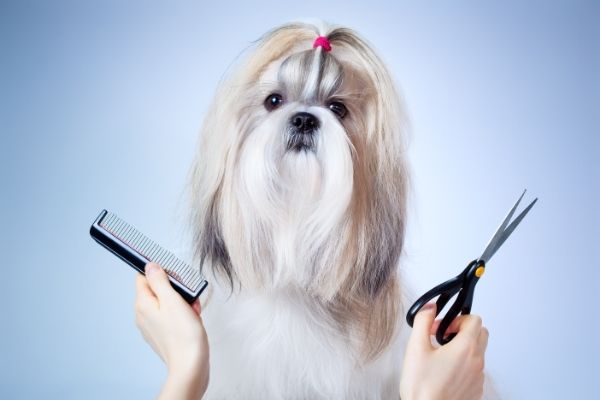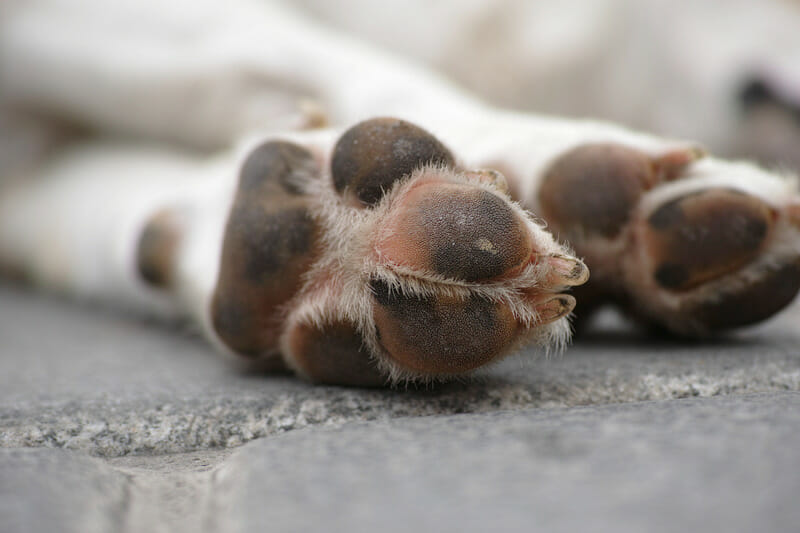Whether you’re a new doggie parent or have had dogs all your life, it’s imperative to understand the importance of grooming your pup at home. Dog grooming plays a key role in keeping your pet happy and healthy, and can even help you bond with your dog! In this guide to dog grooming, you’ll learn:
- Why dog grooming is important
- Which dogs might need haircuts
- What is double-coated dog grooming
- How to clip your dog’s nails
- How to brush your dog‘s hair
- How to bathe your dog
Why is grooming important for dogs?
Dogs seem to love getting dirty, and dogs in the wild must take care of their own grooming. So why does man’s best friend need our help? There are three main reasons why grooming is essential for dogs:
- Human reasons: Keeping your dog clean means less fur all over and less animal dander in the air, which can cause issues for people with asthma and allergies. Since dog fur also tends to lock in odours, proper grooming will also keep bad smells out of your home.
- Comfort reasons: Those odours bug your dog too, as does the weight, itchiness, and general discomfort of having a bunch of dead fur stuck in their coats. Long nails are also uncomfortable—especially dew claws that are too long!
- Health reasons: Not only is grooming good for your dog’s skin and fur; it also helps you keep an eye on their general health. When grooming your dog, take a moment to check for any fleas, ticks, skin abrasions, lumps, bumps, or anything else abnormal.
Pro tip: If you aren’t sure about the needs of your recently adopted pet, consult a veterinarian or a professional groomer. They’ll be able to help you set up the perfect grooming routine for your dog!
Why do some dogs get haircuts?
Many dog breeds, like Labradors, have short fur. The fur on these dogs grows in phases, growing to a certain length, stopping, and then shedding to make space for new fur coming in. However, some breeds have developed fur that is more like human hair, which has a much longer “growth” phase. These breeds seem to have hair that just keeps growing, and can keep getting longer and longer.
Long-haired breeds are more likely to be considered hypoallergenic, because this long growing phase means less shedding—by a lot. But it also means more maintenance! Dogs with long hair are more prone to tangles and matting, and long hair can harbour lots of dead skin and dirt, and even hide pests like fleas and ticks. Brushing is super important for long-haired dog breeds to keep your dog’s hair clean and tangle-free.
Animal advocates are split on the idea of doggie haircuts. Some folks believe that cutting your dog’s coat in the summer can help them be more comfortable, while other experts say that a dog’s fur can actually help them stay cool. During the winter, if you keep your pup’s coat short, be careful not to let them be outside for long periods of time, because you’ve taken away some of their natural protection against the cold. No matter the season, however, remember that if you choose to let your dog’s hair grow out, you must commit to brushing it at least once a day.

Pro tip: Matted fur isn’t just a hassle; it can be extremely painful for your dog. If you find matted fur on your dog, take him to a professional groomer or vet to get the matted fur safely shaved. Don’t try to remove large matts of fur on your own, as you may hurt your dog by accident.
Double-coated dog grooming
In addition to long-haired breeds like shih tzus and yorkies, there is another set of dogs that needs special grooming care. Huskies, malamutes, collies, shepherds, and other dogs that are bred for working in cold weather have what’s called a “double coat.” A double coat consists of guard hairs on the exterior, plus a thick inner layer called the undercoat, which helps insulate these dogs during colder seasons.
Dogs with double coats need to be brushed at least a few times a week or daily, if possible. Instead of using a normal brush that only reaches the top coat of your dog’s fur, you’ll want to get a brush that is specially made for undercoats! These mostly look like rakes or have metal teeth that get below the guard hairs to grab undercoat hairs. Regular trips to the groomer for a full bath and blowout can also help keep your double-coated dog’s fur in good condition and your home hair-free.
Pro tip: Do not shave the hair of your double-coated dog! It might seem like an “easy solution,” but it doesn’t actually reduce shedding and can make your pup prone to skin issues including sunburn. Plus, some dogs’ fur won’t grow back properly after being shaved.
How to clip your dog’s nails
Before you clip your dog’s nails, you’ll need to get them ready. If you’ve adopted a puppy, it’s important to start training him for grooming as soon as possible. You can do this by gently massaging your puppy’s paws, touching them all over, and gently pressing the joint to extend their nails.
If you have adopted an older dog, the process is the same, but you’ll need to be careful: Some dogs are fearful of being touched because of various reasons. Make sure your dog is comfortable with their paws being handled before you try to clip their nails. If your dog shies away, growls, or at worst, nips at you when you reach for a paw, STOP. Talk to your vet about the best way to properly groom your pet while keeping them comfortable, and you, safe.

To clip your dog’s nails, take their paw in your hand, and gently press on their knuckle to extend the nail. Using a clipper made specifically for dogs, gently clip the nail. We recommend doing this in a kitchen or other non-carpeted area, so you can sweep up after. Some folks like to do this outside, so there’s no cleanup necessary!
While clipping, be careful not to cut your dog’s nails too short. Inside the nail is something called a “quick,” which is the furthest end of your dog’s blood vessels and nerves in the paw. If you cut into the quick, it will likely bleed and hurt your dog. If your dog has light or translucent nails, you may be able to see the quick, but if your dog’s nails are opaque, you’ll need to tread carefully. If you do cut the nail “to the quick,” quickly apply pressure with a tissue or towel until the bleeding stops. Give your dog praise and let him rest and recover before you resume nail clipping.
Pro tip: There are different types of clippers to choose from, and different sizes based on the size of your dog! For bigger breeds, make sure you choose a sturdy pair with easily graspable handles.
How to brush your dog’s hair
As with nail clipping, first make sure that your dog is comfortable being touched all over. If your dog is scared of new objects, give him a minute to smell and get used to the brush itself. Then, brush your dog gently in the direction his hair lays. Never brush the fur in the opposite direction, as this will be very uncomfortable for him.
If you come across any knots or tangles, work through them carefully, being sure not to pull on your dog’s skin. If you cannot get a small knot undone, you can clip it with a set of pet scissors. As you go, clean out the brush frequently so you can remove as much dead fur as possible. Don’t brush your dog for too long or go over the same spot again and again. Over-brushing can irritate your dog’s skin!
Depending on your dog’s breed, you may need to brush him at different frequency. Most dogs should be brushed at least two to three times per week. However, long-haired breeds and dogs that shed more should be brushed every day!
Pro tip: Ask your vet or groomer which type of brush will be most effective for your dog’s fur. While a double-coated dog needs a deshedder, long-haired dogs do well with bristle brushes, combs for tangles, and soft brushes for super-shiny coats. Make sure you have the right tools for easy grooming.
How to bathe your dog
Before bathing your dog, you’ll need to decide where you’ll be bathing your pup. You can bathe your dog in a bathtub or outside if the weather is warm. You can also go to many dog stores that have “self-grooming” stations!
You’ll also want to make sure you have the right tools. You’ll need:
- A hand-held spray nozzle or cup for soaking your dog
- A pet-safe shampoo
- A leash to keep your dog in place and in control
- A brush
- A towel or blow-dryer
- Plenty of treats
To bathe your dog, start by gently getting all the fur wet. Avoid getting your dog’s head and face wet; you especially don’t want to get water in your dog’s ears. If your dog’s face needs to be cleaned, you can use a warm washcloth to gently wipe the face and outer ears. Then, add some pet shampoo to your hands and gently lather it into your dog’s fur. Make sure to get your dog’s legs and belly, too!
Once your dog is all soaped up, it’s time to rinse! Make sure you get ALL the shampoo out of your dog’s fur—shampoo that’s left behind can irritate their sensitive skin. Run your dog over with a brush to remove as much dead fur as possible. Then, you can gently dry your dog with a towel, or you can blow dry his fur if he enjoys it!
Pro tip: Dogs have very sensitive skin, and pet-safe shampoo is made with this in mind. Shampoo for humans is harsher than pet shampoos, and using it on your dog may lead to skin irritation.
Let’s review: dog grooming
By now, you’re an expert in dog grooming at home. You’ve learned:
- The three reasons dog grooming is important
- How to clip your dog’s nails
- How to bathe and brush your dog
- And how to care for long-haired and double-coated dogs
When you follow a proper grooming routine with your dog at home, you ensure that your pet stays healthy and happy, and you keep your home free of shed fur and bad odours. Your dog, family, and friends will all thank you!
For more information on a puppy’s important firsts, adopting an adult rescue dog, and more dog-related articles, check out our blog.
Cover photo by Autri Taheri on Unsplash
Leave a comment
Your email address will not be published. All fields are required.